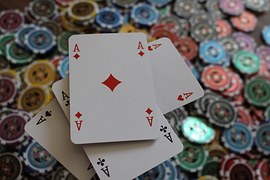
If you start playing in larger tournaments or tournaments held in the same casinos, you will often start encountering the same players. This provides great opportunities to take advantage of opponents who are overly aggressive pre-flop.
Overly aggressive players pre-flop are very easy to spot. They raise far too often. You can treat these players like personal chip ATMs. Just re-raise them and they will fold. All you need is a little bit of courage.
Example:
You have A ♠– 4♣. It's the late stage of the tournament. You have 50,000 and are in 9th place out of 30 remaining players. The blinds are 1000-2000. A poker professional opens the betting to 8000. The aggressor sees you as one of the ABC poker type players, which means you play very predictably. Everyone folds to you in the Big Blind. What should you do?
You have 25 Big Blinds, so you don't have to do anything drastic. However, this player is pressuring the entire table with frequent pre-flop raises. He can't have a strong hand every time, right?
Your hand doesn't play very well post-flop, so just calling is a poor option. You could just play it safe and fold. However, if you re-raise him to 30,000, almost always your opponent will fold.
This is a great way to increase your chip stack because these aggressive players can't always have a strong hand, and they won't want to tangle with a tight player whose re-raise signals a very strong hand.
A mistake that players often make in such situations is that they wait for strong hands hoping to then re-raise their opponent. Unfortunately, you will get strong hands too rarely.
Another thing players like to do is just call pre-flop with a strong hand. They get a hand like A♠ – 10 ♠, but are afraid to re-raise, so they just call. Unfortunately, two out of three times, the flop will not fit their cards at all.
Tip: Timing is everything
Re-raising an aggressive player works great in all cases, except when the opponent gets a monstrously good hand. One way to recognize if a player has pocket aces (or kings) is to watch how he observes what happens after his raise. If you notice that he starts watching everything more closely in this hand than before, be careful, he wants action.





